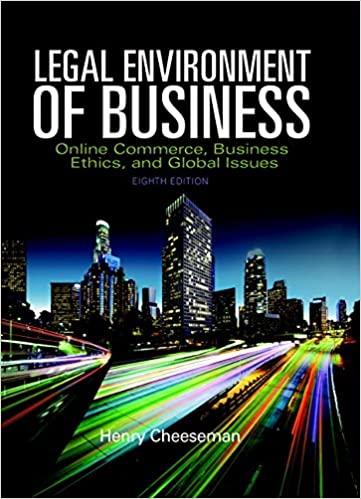Question
QUESTION 1 (a) Culpability deals with the question whether the conduct of a particular person is against the objective legal convictions of society. (b) If
QUESTION 1 (a) Culpability deals with the question whether the conduct of a particular person is against the objective legal convictions of society. (b) If X, who had killed his wife and children, is charged with murder and acquitted on the ground that he had lacked criminal capacity as a result of a mental illness, he may nevertheless be convicted of the lesser crime of culpable homicide.
(1) None of the statements are correct.
(2) Only statement (a) is correct.
(3) Both statements (a) and (b) are correct.
(4) Only statement (b) is correct.
QUESTION 2
(a) Provocation is a ground of justification which excludes the unlawfulness of conduct.
(b) Although a child between the ages of 10 and 14 years is presumed to lack criminal capacity, the state is free to rebut this presumption.
(1) Both statements (a) and (b) are correct.
(2) None of the statements are correct.
(3) Only statement (a) is correct.
(4) Only statement (b) is correct
QUESTION 3 (a) The test for culpability in the form of intention includes an investigation regarding the motive of the accused for committing the offence. (b) An example of dolus indirectus is where X, in firing a shot at Y, foresees the possibility that his shot may hit Y's child who is standing next to Y, and that he reconciles himself to this possibility.
(1) Only statement (a) is correct.
(2) Only statement (b) is correct.
(3) None of the statements are correct.
(4) Only statements (a) and (c) are correct.
QUESTION 4
(a) In Humphreys 2013 (2) SACR 1 (SCA), the court held that dolus eventualis was present because X ought to have foreseen or must have foreseen the possibility of the consequence ensuing. (b) If X assaults Y, and then ties her to a tree in a remote area where no person ever comes so that she cannot report the crime to the police, and Y's dead body is later found, it may be argued that X had intention to commit murder in the form of dolus eventualis.
(1) Only statement (a) is correct.
(2) Only statement (b) is correct.
(3) Both statements (a) and (b) are correct.
(4) None of the statements are correct.
QUESTION 5
(a) If X fires a shot at an object believing it to be an animal, and it turns out to be a human being, X can, on a charge of murder, rely on the defence of mistake. (b) Mistake must be reasonable in order to exclude intention.
(1) None of the statements are correct.
(2) Both statements (a) and (b) are correct.
(3) Only statement (a) is correct.
(4) Only statement (b) is correct.
QUESTION 6
(a) If X fires a shot at Y, and the bullet hits a telephone pole, moves in a different direction, and hits and kills Z instead, X, if charged with the murder of Z, may rely on the defence of mistake. (b) Putative private defence is a defence which excludes the element of culpability, and not the element of unlawfulness.
(1) Only statement (a) is correct.
(2) Only statement (b) is correct.
(3) Both statements (a) and (b) are correct.
(4) None of the statements are correct.
QUESTION 7
(a) If a person acted negligently, it means that he did not perform a voluntary act. (b) In Chretien 1981 (1) SA 1097 (A), the court found the accused guilty of assault in respect of the persons that he had injured.
(1) Both statements (a) and (b) are correct.
(2) None of the statements are correct.
(3) Only statement (a) is correct.
(4) Only statement (b) is correct.
QUESTION 8
(a) X may rely on the defence of provocation on a charge of murder only as a ground for mitigation of punishment. (b) If X buys drugs for his own use and Y acts merely as interpreter to the transaction, Y can qualify as an accomplice.
(1) Only statement (a) is correct.
(2) Both statements (a) and (b) are correct.
(3) None of the statements are correct.
(4) Only statement (b) is correct.
QUESTION 9
(a) A "joiner-in" is a person who does not act with a common purpose with other persons to commit a crime. (b) In Molimi 2006 (2) SACR 8 (SCA), the Supreme Court of Appeal held that conduct by a member of a group of persons which differs from the original mandate may not be imputed to the other members unless each member had intention in respect of the prohibited result caused by the act.
(1) Both statements (a) and (b) are correct.
(2) Only statement (b) is correct.
(3) Only statement (a) is correct.
(4) None of the statements are correct.
QUESTION 10
(a) In Schoombie 1945 AD 541, the Appeal Court confirmed X's conviction of (completed) arson on the basis that X's act qualified as an act of execution or consummation. (b) Where X, who is HIV-positive and is fully aware of this, rapes Y without taking preventative measures (for example, using a condom), he/she may be convicted of rape as well as attempted murder.
(1) Only statement (a) is correct.
(2) Both statements (a) and (b) are correct.
(3) Only statement (b) is correct.
(4) None of the statements are correct
Step by Step Solution
There are 3 Steps involved in it
Step: 1

Get Instant Access to Expert-Tailored Solutions
See step-by-step solutions with expert insights and AI powered tools for academic success
Step: 2

Step: 3

Ace Your Homework with AI
Get the answers you need in no time with our AI-driven, step-by-step assistance
Get Started


